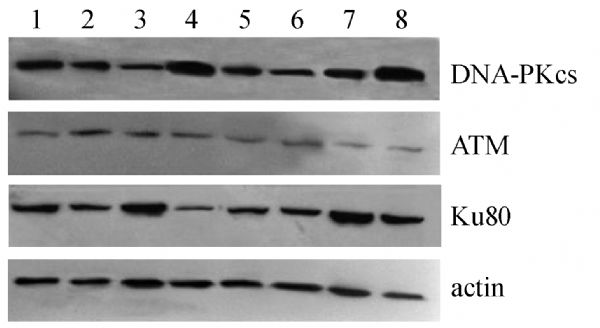

Correlativity study between expression of DNA double-strand break repair protein and radiosensitivity of tumor cells
Received date: 02 Jul 2008
Accepted date: 10 Aug 2008
Published date: 05 Mar 2009
Copyright
DNA double-strand break (DSB) is generally regarded as the most lethal of all DNA lesions after radiation. Ku80, DNA-PK catalytic subunit (DNA-PKcs) and ataxia telangiectasia mutated (ATM) proteins are major DSB repair proteins. In this study, survival fraction at 2Gy (SF2) values of eight human tumor cell lines (including four human cervical carcinoma cell lines HeLa, SiHa, C33A, Caski, three human breast carcinoma cell lines MCF-7, MDA-MB-231, MDA-MB-453, and one human lung carcinoma cell line A549) were acquired by clone formation assay, and western blot was applied to detect the expressions of Ku80, DNA-PKcs and ATM protein. The correlativity of protein expression with SF2 value was analyzed by Pearson linear correlation analysis. We found that the expression of same protein in different cell lines and the expression of three proteins in the same cell line had a significant difference. The SF2 values were also different in eight tumor cell lines and there was a positive correlativity between the expression of DNA-PKcs and SF2 (r =0.723, P = 0.043), but Ku80 and ATM expression had no correlation with SF2 (P>0.05). These findings suggest that the expression level of DNA-PKcs protein can be an indicator for predicting the radiosensitivity of tumor cells.

Liang ZHUANG , Shiying YU , Xiaoyuan HUANG , Yang CAO , Huihua XIONG . Correlativity study between expression of DNA double-strand break repair protein and radiosensitivity of tumor cells[J]. Frontiers of Medicine, 2009 , 3(1) : 26 -29 . DOI: 10.1007/s11684-009-0008-7
| 1 |
Van GentD C, HoeijmakersJ H, KanaarR. Chromosomal stability and the DNA double-stranded break connection. Nat Rev Genet, 2001, 2(3): 196–206
|
| 2 |
WeteringsE, ChenD J. DNA-dependent protein kinase in nonhomologous end joining: a lock with multiple keys?J Cell Biol, 2007, 179(2): 183–186
|
| 3 |
CollisS J, DeWeeseT L, JeggoP A, ParkerA R. The life and death of DNA-PK. Oncogene, 2005, 24(6): 949–961
|
| 4 |
LieberM R, MaY, PannickeU, SchwarzK. Mechanism and regulation of human non-homologous DNA end-joining. Nat Rev Mol Cell Biol, 2003, 4(9): 712–720
|
| 5 |
ValerieK, PovirkL F. Regulation and mechanisms of mammalian double-strand break repair. Oncogene, 2003, 22(37): 5792–5812
|
| 6 |
WalkerJ R, CorpinaR A, GoldbergJ. Structure of the Ku heterodimer bound to DNA and its implications for double-strand break repair. Nature, 2001, 412(6847): 607–614
|
| 7 |
DipR, NaegeliH. More than just strand breaks: the recognition of structural DNA discontinuities by DNA-dependent protein kinase catalytic subunit. FASEB J, 2005, 19(7): 704–715
|
| 8 |
BudmanJ, ChuG. Processing of DNA for nonhomologous end-joining by cell-free extract. EMBO J, 2005, 24(4): 849–860
|
| 9 |
BoskovicJ, Rivera-CalzadaA, MamanJ D, ChacónP, WillisonK R, PearlL H, LlorcaO. Visualization of DNA-induced conformational changes in the DNA repair kinase DNA-PKcs. EMBO J, 2003, 22(21): 5875–5882
|
| 10 |
PawelczakK S, TurchiJ J. A mechanism for DNA-PK activation requiring unique contributions from each strand of a DNA terminus and implications for microhomology-mediated nonhomologous DNA end joining. Nucleic Acids Res, 2008, 36(12): 4022–4031
|
| 11 |
SakataK, SomeyaM, MatsumotoY, HareyamaM. Ability to repair DNA double-strand breaks related to cancer susceptibility and radiosensitivity. Radiat Med, 2007, 25(9): 433–438
|
| 12 |
ZhuangL, YuS Y, HuangX Y, GaoQ L, XiongH, LengY. Effect of Ku80 expression inhibition by RNA interference on proliferation of cervical carcinoma cell line HeLa. Ai Zheng, 2007, 26(3): 252–257 (in Chinese)
|
| 13 |
RampakakisE, Di PaolaD, Zannis-HadjopoulosM. Ku is involved in cell growth, DNA replication and G1-S transition. J Cell Sci, 2008, 121(Pt 5): 590–600
|
| 14 |
HsuH L, GilleyD, GalandeS A, HandeM P, AllenB, KimS H, LiG C, CampisiJ, Kohwi-ShigematsuT, ChenD J. Ku acts in a unique way at the mammalian telomere to prevent end joining. Genes Dev, 2000, 14(22): 2807–2812
|
| 15 |
BaileyS M, BrennemanM A, HalbrookJ, NickoloffJ A, UllrichR L, GoodwinE H. The kinase activity of DNA-PK is required to protect mammalian telomeres. DNA Repair (Amst), 2004, 3(3): 225–233
|
| 16 |
SirzenF, NilssonA, ZhivotovskyB, LewensohnR. DNA-dependent protein kinase content and activity in lung carcinoma cell lines: correlation with intrinsic radiosensitivity. Eur J Cancer, 1999, 35(1): 111–116
|
| 17 |
ShintaniS, MiharaM, LiC, NakaharaY, HinoS, NakashiroK, HamakawaH. Up-regulation of DNA-dependent protein kinase correlates with radiation resistance in oral squamous cell carcinoma. Cancer Sci, 2003, 94(10): 894–900
|
| 18 |
ZhaoH J, HosoiY, MiyachiH, IshiiK, YoshidaM, NemotoK, TakaiY, YamadaS, SuzukiN, OnoT. DNA-dependent protein kinase activity correlates with Ku70 expression and radiation sensitivity in esophageal cancer cell lines. Clin Cancer Res, 2000, 6(3): 1073–1078
|
| 19 |
MorioT, KimH. Ku, Artemis, and ataxia-telangiectasia-mutated: signalling networks in DNA damage. Int J Biochem Cell Biol, 2008, 40(4): 598–603
|
| 20 |
BurmaS, ChenD J. Role of DNA-PK in the cellular response to DNA double-strand breaks. DNA Repair (Amst), 2004, 3(8-9): 909–918
|
| 21 |
HammarstenO, ChuG. DNA-dependent protein kinase: DNA binding and activation in the absenceβofβKu. Proc Natl Acad Sci USA, 1998, 95(2): 525–530
|
| 22 |
WestR B, YanevaM, LieberM R. Productive and nonproductive complexes of Ku and DNA-dependent protein kinase at DNA termini. Mol Cell Biol, 1998, 18(10): 5908–5920
|
| 23 |
SallesB, CalsouP, FritP, MullerC. The DNA repair complex DNA-PK, a pharmacological target in cancer chemotherapy and radiotherapy. Pathol Biol (Paris), 2006, 54(4): 185–193
|
| 24 |
KelleyM R, FishelM L. DNA repair proteins as molecular targets for cancer therapeutics. Anticancer Agents Med Chem, 2008, 8(4): 417–425
|
/
| 〈 |
|
〉 |